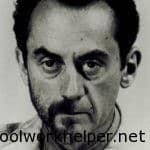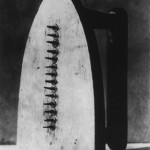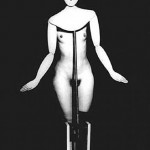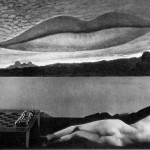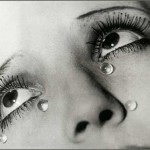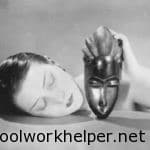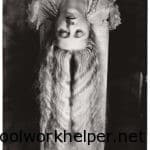Man Ray was born on August 27, 1890, in Philadelphia, and moved to New York with his family seven years later. From 1909 to 1912 he studied at the Francisco Social Center Academy of Art, New York while frequently visiting Alfred Stieglitz’s gallery “291”. He attended classes at the Ferrer Center in 1912 for drawing and watercolors. Man Ray attempted to form an artist’s commune in 1913 with the poet Alfred Kreymborg.
He had his first solo show at the Daniel Gallery in New York in 1915, and around this time, he took up photography, the medium for which he is 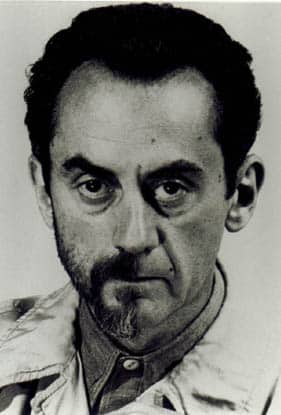 best known. By 1916, Ray’s photography had come into full swing, and he founded the “society of Independent Artists” together with Marcel Duchamp and Walter Arensberg. In 1917, Man Ray created his first aerographs and went on to photographic and film experiments with duchamp in 1920. In 1921, Ray invented the Rayographs and had his first important exibition in the “Librairie Six”, Paris. In 1922, Ray began his work with nude photography, and takes photos for various magazines- fashion photos, and portraits. In 1923, Ray’s first film was shown, “Le retour a la raison”. In 1925, he took part in his first surrealist exhibition in the galerie Pierre, Paris, and was from then on associated with the surrealists. Man Ray’s art did well, and he had many shows in both France and America. Ray began to get more and more involved with the surrealists and his works accompanied many poems and books. In 1940, Man Ray fled to the US, shortly before Germany’s occupation of France and he had exhibitions in Los Angeles, San Franscisco, Santa Barbara, Pasadena, and New York. Man Ray returned to Paris in 1951, and in 1960, he had solo exhibitions in Photokina, Cologne. He was awarded the gold metal for photography at the Biennale, in Venice. In 1963, he published his autobiography, entitled “Self-Portrait” in London, and in 1966 he had his first large retrospective in the Los Angeles County Museum of Art. Further retrospectives were shown all over Europe, and Man Ray had several international solo exhibitions. He died November 18th, 1976 in Paris.
best known. By 1916, Ray’s photography had come into full swing, and he founded the “society of Independent Artists” together with Marcel Duchamp and Walter Arensberg. In 1917, Man Ray created his first aerographs and went on to photographic and film experiments with duchamp in 1920. In 1921, Ray invented the Rayographs and had his first important exibition in the “Librairie Six”, Paris. In 1922, Ray began his work with nude photography, and takes photos for various magazines- fashion photos, and portraits. In 1923, Ray’s first film was shown, “Le retour a la raison”. In 1925, he took part in his first surrealist exhibition in the galerie Pierre, Paris, and was from then on associated with the surrealists. Man Ray’s art did well, and he had many shows in both France and America. Ray began to get more and more involved with the surrealists and his works accompanied many poems and books. In 1940, Man Ray fled to the US, shortly before Germany’s occupation of France and he had exhibitions in Los Angeles, San Franscisco, Santa Barbara, Pasadena, and New York. Man Ray returned to Paris in 1951, and in 1960, he had solo exhibitions in Photokina, Cologne. He was awarded the gold metal for photography at the Biennale, in Venice. In 1963, he published his autobiography, entitled “Self-Portrait” in London, and in 1966 he had his first large retrospective in the Los Angeles County Museum of Art. Further retrospectives were shown all over Europe, and Man Ray had several international solo exhibitions. He died November 18th, 1976 in Paris.
Man Ray, the artist:
Man Ray was a painter and photographer in the Dada, surrealist, and abstract art movements of the 1920s and 1930s. In the beginning, he was a struggling young artist in New York. Man Ray did not take up photography until he reached Paris in the early 20’s; and he did so, initially out of need rather than desire and also because no one, he felt could reproduce his paintings well enough, and he wanted to take the matter in his own hands. Unable to sell his paintings, he turned to fashion photography and portraiture- he became a portrait photographer to the intellectual avant-garde. He was very successful in both areas. By 1921, Man Ray’s work was causing something of a sensation due to his use of natural light, sharp clear contrast and informal poses. “His work seemed extreme or avant-guarde at a time when Pictorialism was still the predominant style of photography in Europe.” (Guggenheim website)
Man Ray’s commercial success as a fashion and portrait photographer allowed him the freedom to pursue experimental ideas related to his interest in the Dada art movement and later Surrealism. He disregarded standards of art of his time, and his curious nature led to his discovery of the “Rayograph,” later to be called the photogram, and solarizations. He deliberately used “fault” techniques for aesthetic purposes- “solarization (exposing the captured image to a flash of light during development to produce a strikingly dark contour), granulation (emphasizing the silver grains of the light-sensitive medium to give the picture an irregular pointed texture), negative printing (reversing the black and white elements of a picture to alienate and enhance the impact of the image), distortions (angling the enlarger to produce an oblique image of reality), relief processing (placing a transparency over a slightly displaced negative to create a three-dimensional effect on the ultimate print)” (Man Ray, pg. 9). These techniques became instruments of creative design.
Man Ray not only experimented with technique, but also with the nude female body. He is quoted to have said, “Speaking of nudes, I have always had a great fondness for this subject, both in my paintings and in my photos, and I must admit, not for purely artistic reasons”. The females feuled Man Ray’s imagination and inspired him to works of photographic ingenius. “The pictures exude not blatant sex but veiled, exciting eroticism” (Man Ray, pg. 9). Many of Ray’s subjects were celebrities, but even when the subject remained anonymous, the observer could sense that the woman in the photograph must have inspired Man Ray as a man, and as an artist.
Man Ray was “an artist of quick wit and a sincere disinterest in too much artistic self-absorbtion” (Guggenheim website). He was an architect, painter, draughtsman, sculptor, writer, cabinet maker, goldsmith, filmmaker and of course a photographer. Given the many fields in which he demonstrated his talent, the fact that he is today known primarily for his photography, is due to the great volume of his photographic work, and the number of his photographs published in books and periodicals. To sum him up, Man Ray was a “master of the captured and created image, a man of sparkling wit and a lover of beautiful women” (Man Ray, pg. 8 )

